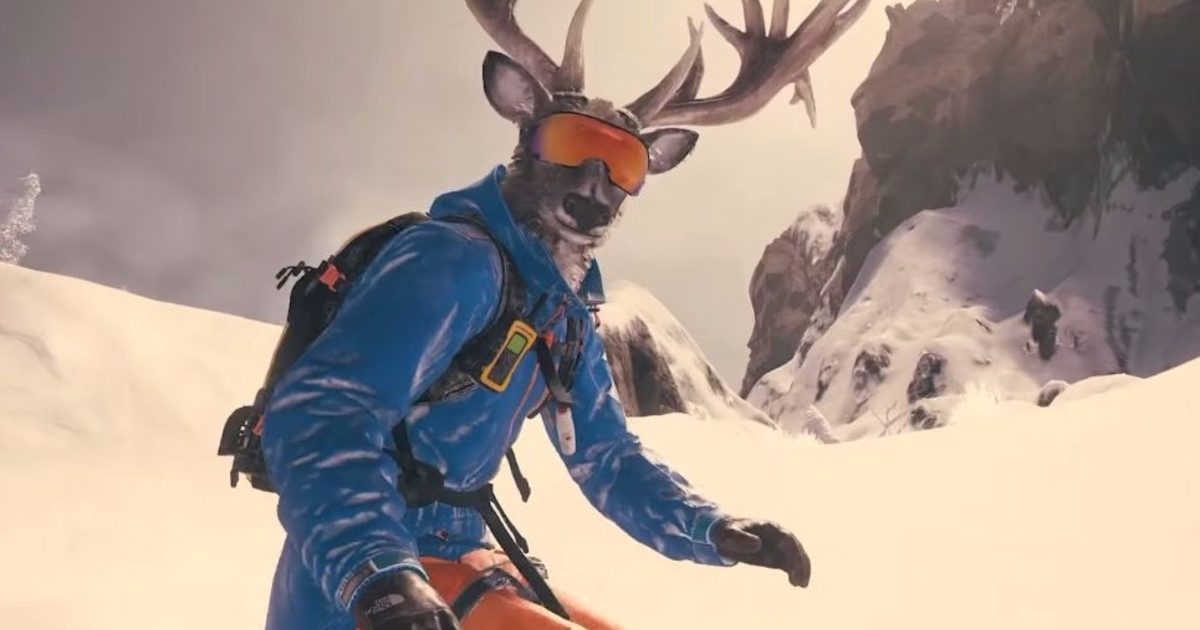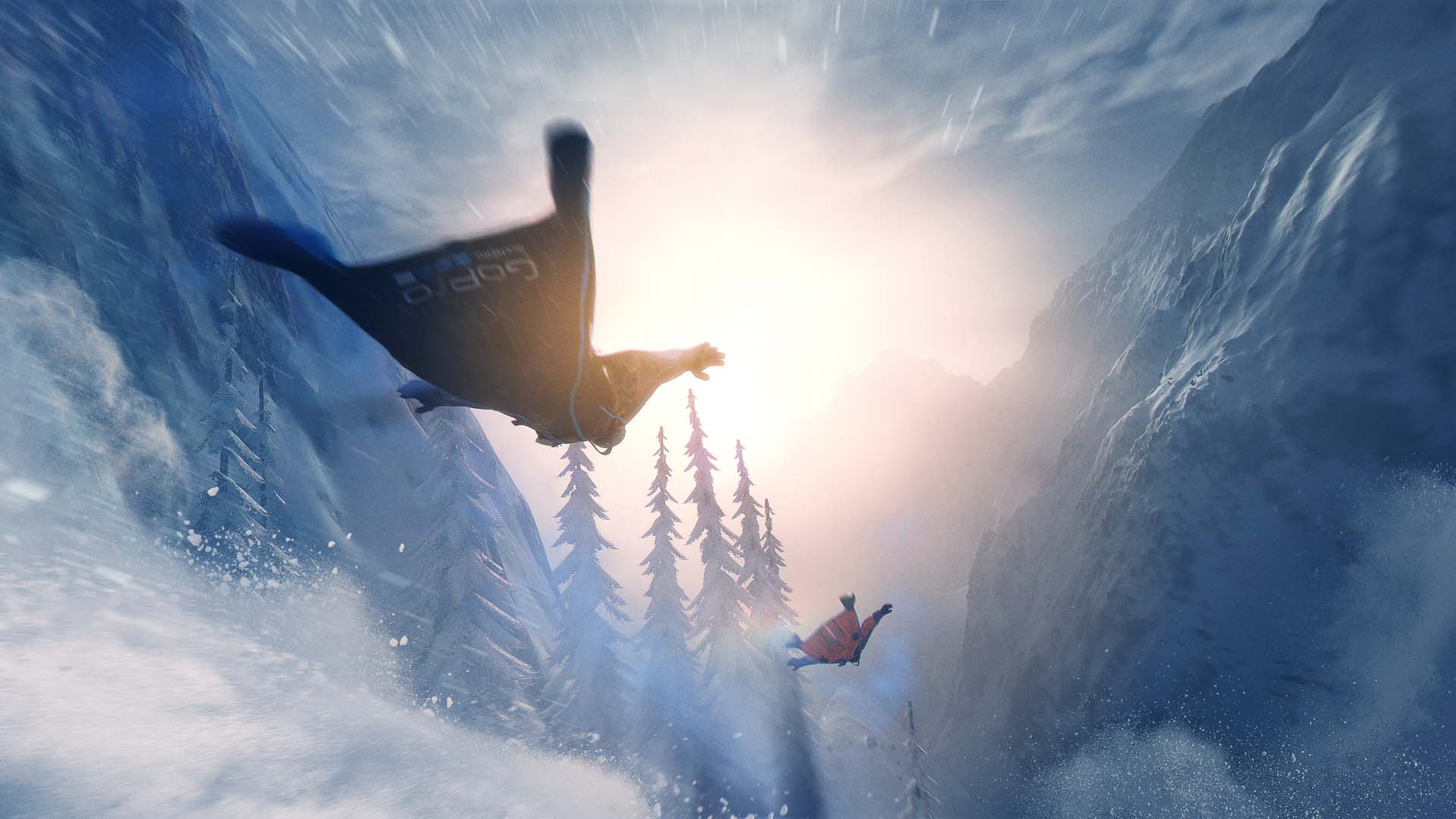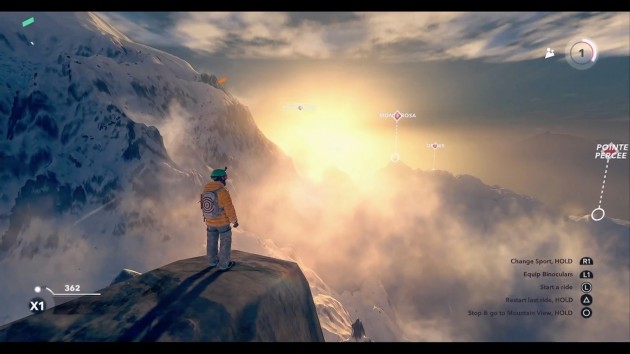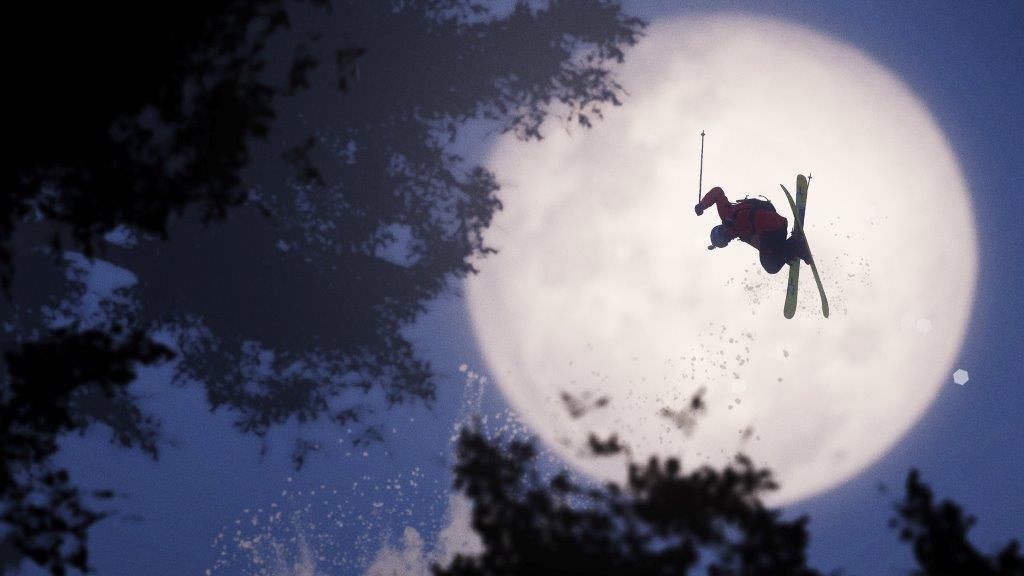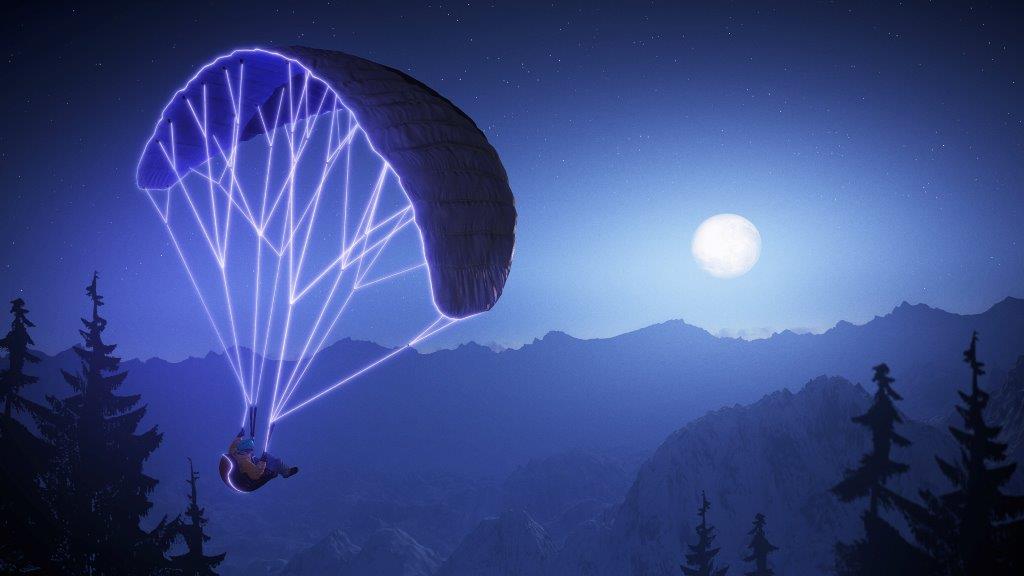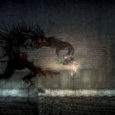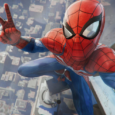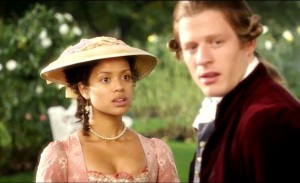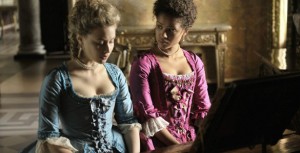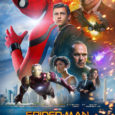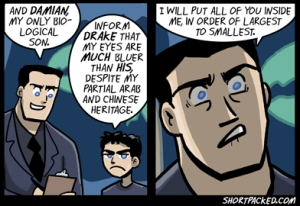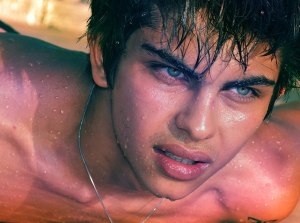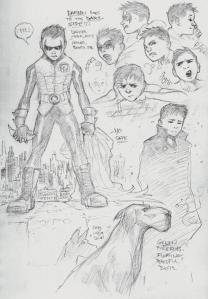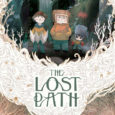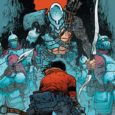Long has the winter extreme sports genre laid dormant, until Ubisoft awakens a game like Steep from its creative slumber. The team over at Ubisoft does a lot of good with Steep, an open world mountain simulator where you get to, snowboard, wind-suit, paraglide, ski, and walk across a frozen paradise. While the team nails the sense of speed, there are some shortcomings that hold this game back from being truly, genre defining.
Apparent right off the bat, are the recreated Alps, open world in all its beautiful and digital glory. The graphics are near lifelike as I stand atop a mountain that a helicopter has just dropped me off on, and gaze at all the powder that I am about to shred. Character models are detailed well but there are no customization options in terms of how your physical appearance is represented. However, you do get a choice of pre-set character models and you can change the clothing of. This cosmetic only customization is sure to bother some, but the mechanics themselves make up for these shortcomings.
Steep goes for a much more realistic take on the sports than say a franchise like SSX, or 1080 Snowboarding. You won’t be unhooking your board, and swinging it over your head like a helicopter propeller. Instead, the game feels much more like the game franchise, Skate. The tricks are more standard, and less flashy, and I think that works in this game’s favor. Steep still lets you bring the funny as you can don some goofy looking suits, and act out some pretty bizarre furry adventures as you glide down the slopes in a panda costume. The silliness ends there though, as the real focus is on recreating the feelings of these extreme sports.
The controls are rather simplistic, but take some time to actually master. Pulling off tricks is as easy as nailing a jump at the right time and then manipulating a series of R1, L1, and joystick maneuvers to pull off some real life moves when on skis or a snowboard. The sense of speed that is built through these courses is perfect, and nailing a good speed run or a series of tricks is gratifying.
The paraglider is easy enough as you float along, catching updrafts as you go point to point. This event can most often times be more boring than entertaining. I found myself skipping these missions as often as possible. Wing-suiting may be the star of the show. Nailing a perfect drop and course run is intense, and induces the urge to stand up and cheer as you celebrate your close calls as you fly dangerously close to the environment. This is the best feeling wing-suit mechanics in the medium, as I feel like I have absolute control over my glider.
The walking around may be the most polarizing aspect of this game. Steep encourages you to take a moment to walk around, and explore. Doing this will unlock more drop off points to start new races. New summits will be unlocked as you increase your player level, and on these summits are increasingly difficult races and events. At some point the game will force you to walk around. While I may call it tranquil and serene; I have found many that have called it tedious, boring, and time consuming. I will ask that you let your own preference guide you on how the walking portions will make you feel.
Leveling up in this game feels empty. Your character does not get stronger, faster, or better at balancing. The costumes, and clothing, and items you unlock have no stats are baring on your performance either. Everything in this game is cosmetic including your level number, which to me is a shame. I wish these things stood for something more, but there is something to be said about a game that gives you everything at the start, and has you relying on pure skill and not stat boosting upgrades.
My biggest issue with this game is one that had me constantly frustrated. There is no easy way to find a race type you are looking for. When choosing a race to tackle next, the game has you going to a world map and choosing a series of flags that represent a race off of said map. There are so many different types of races and tracks, and I was usually looking for a specific one to show off to a friend of co-op partner. To find that specific race, I would have to locate it on this cluttered world map, with strangely marked iconography to loosely represent the event. This world map is basically littered with these varied races. The events are dotted like chicken pox all across the face of the map as you try and decipher which race is which. I found myself constantly frustrated as I tried to find a specific event type, only to lose patience and just choose any event. This is extremely poor mission design.
The multiplayer is another pillar of mediocrity for Steep. Real players will bleed in and out of your world and races as you explore around and participate in the events. It is not uncommon to see people engaging in the same races you are, but it never quite feels like you are racing with/against them. It feels more like they are just participating in timed events with you, racing against their own times, and leader-board scores. Sure it is a lot of fun to have these players shredding around with you, but it still feels like an empty experience. I never once felts like I was working towards the same goal with my partner or opponent. This is a racing game right? Why don’t I feel that urgency in the events?
There are user created events, and you have the ability to share your own runs down the mountain for others to compete against your time, but I found the menus to be convoluted and confusing. I’m sure some may not have an issue with the navigation, but I felt they could have presented the information in a much clearer way. This content does have the ability to extend the life of the game, but at the end of the day you are still going down the same mountain sides, using the same equipment, with the only goal being to get a better time or score.
Steep truly shines when a singular event has multiple traversal styles. There was a particular race in the game that has you using all modes of transportation as you make your way across the mountain range. Switching between all the mode of transportation to ensure you reach the finish line, is as tactical as it is exhilarating. I just wish there were more moments like this.
Steep has a lot going on for it. It is easily the best extreme winter sports game in years, but then again it has not had much competition. I feel a few updates and additions could fix the issues I had with the game, however its final and last issue I will share may be a deal breaker to some. Steep has very little content. It takes a week or two of play to max out your character level to the cap of 25. The amount of different race types is little as well when compared to others in the genre and their mode types. Perhaps DLC could extend the life of this game, but I think selling a season pass on top of the game’s full price is a tall order to ask of people.
I think Steep can be a perfect pallet cleanser at the end of the year as you come off of huge experiences like Watch Dogs 2, Dishonored 2, and Final Fantasy XV. Is it worth the full price? Well that depends on how much you enjoy striving for bettering your times and scores, because it is hard for me to recommend the game based off the amount of content alone. What you will get with Steep though, is a true sense of speed, amazing controls, and a beautiful open world. If that is enough for you, there will be plenty of fun to be had with this game.
Belle is a refreshing and important film to emerge from a long line of actual BBC helmed and or in this case, BBC-style ( I can’t believe it’s not BBC!) historical drama, romance, and classic novel-to-film treatments.While some said literary productions, mini-series and the like have begun to do more color-blind casting for historical dramas; the general atmosphere of said dreamy dramas is always…really white. I mean, yes, many characters in Dickens, Austen, Bronte and the like were white, but it’s 2014; about time to take some creative liberties. Give me a black Elizabeth Bennet already.
Belle is so far one of the few that gets us close to that, and in fact goes far beyond. It’s important and stands out because it’s lead is a woman of color, based on an actual person. That alone is striking and different. And yet with this film’s romance plotline’s ultimate predictability (that comes with the genre) and genuine earnestness, makes it no different than the sea of historical romances that have come before and will come after. It belongs. Which is the point, and a good thing. It’s not often you get a period film with characters of color as the lead, let alone one with an underlying romance granted to them. God forbid non-white people fall in love and are allowed to be vulnerable. It is a shame it’s so infrequent in Western film, particularly of this genre, because director Amma Asante and writer Misan Sagay with Belle shows how it can be effortlessly done. It’s not a stretch or a chore. It’s literally the same. To suggest otherwise or it impossible is ridiculous.
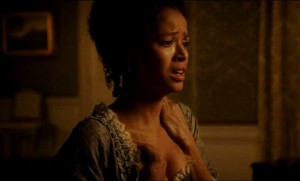
A heartbreaking scene where Dido ( Gugu Mbatha-Raw) melts down as she looks into the mirror. The film shows Dido’s struggle amongst the microagressions of the period despite her genteel upbringing.
HISTORY LESSON:
The film with its “and the kitchen-sink” all-star cast of British actors follows a dramatized life of the real 18th Century lady of color, Dido Elizabeth Belle (portrayed beautifully by Gugu Mbatha-Raw). Dido, illegitimate daughter of Admiral Sir John Lindsay (portrayed in a more or less moving cameo by Matthew Goode) and a black woman named Maria Belle, grew up as a free gentlewoman in the house of her great-uncle, William Murray, 1st Earl of Mansfield (Tom Wilkinson) after her mother dies. She lived there alongside her white cousin, Elizabeth Mary Murray (Sarah Gadon) whilst her great-uncle, who happened to be Lord Chief Justice, had to tend to large, controversial and racially based cases, Somerset v Stewart and the Zong massacre. His verdicts on both cases marked steps towards abolishing slavery in Britain, with his verdict for the former case ruling that slavery had never been established by statute in England and was not supported by common law. (Not to say that cleansed Britain of its horrific colonialism and treatment of peoples in India, Africa, China, and Australia among other places for the next 200 years to follow).
The film chose to follow the Zong case, filling in the gaps of what we know about Dido’s life as both a lady and as an heiress after the death of her father abroad. It elaborates greatly but shows how Dido is controlled by the strict racially based social constructs that even her family, who loves her, must more or less adhere to. She is not a servant; but she is not allowed to dine with the family when guests are over, rather is deemed Elizabeth’s lady companion later in the parlor. She is technically wealthy, especially after her father’s passing, but her skin denies her the perceived eligibility that her cousin has amongst the upper class. It’s all surprisingly very Austen. And the sensitivity shown in how it affects Belle; what she pays attention to (the paintings in her Great-Uncle’s gallery, sign paintings, etc of white people and black servants, thus her hesitation and anxiety to being painted alongside Elizabeth) is also well done.
Whilst a bubbling attraction occurs between young Dido and abolitionist preacher and aspiring lawyer John Davinier ( Sam Reid, in a revisionist version of her real life eventual husband) from the local country parish, you see a gradual thawing of her family and her eventual integration and introduction as a lady alongside her cousin. The dealings of the icy social constructs of the time, both as a woman and a being of mixed race are on full spotlight as Dido deals with her and particularly Elizabeth’s coming out. These are perhaps some of the best moments of the film as they bring out rather layered emotional content. It’s these shades of grey views of racism displayed during this portion of the film that are the most effective. It mirrors real life and institutionalized racism still is in place today, even in kind liberal people.
Whilst in real life her white cousin Elizabeth was also, I believe, an heiress, and wealthy, in the film they are painted as more or less inverses of each other; Dido’s father loved her, and following his death, she is wealthy, but has no position and her heritage impedes her. Elizabeth’s father is painted as negligent and whilst visually the perfect English Rose, she is given no dowry so while she has a title, she was not wealthy and or have property and thus not very desirable to upper class young men. It is then Dido who ultimately gets engaged before her cousin. Despite this; the relationship between the two girls is never truly sour (it’s believed they were rather affectionate in real life if going by the painting of the two women) and this alone is a breath of fresh air compared to what it could have been had it been handled less gently by a more “Hollywood” hand. Their relationship is loving, like sisters. And that is amazing to see on film for any movie with more than one female character regardless of the context.
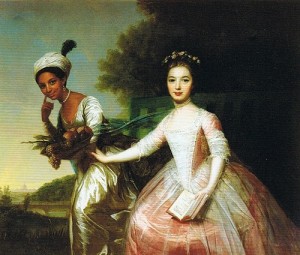
The famous portrait of Dido and Elizabeth, which whilst being painted in the film stirs Dido’s concern and anxiety over being placed as “lower” than Elizabeth in the picture as most black or mixed race peoples are usually depicted, which ultimately does not occur. Elizabeth’s hand on her cousin’s waist denotes affection.
This friction in terms of eligibility between the two girls and their personal pitfalls (having what the other needs more or less) is emphasized during their courting by the snobby and power hungry sons of Lord Ashford; James (Tom Felton) and Oliver (James Norton). This part of the film is most interesting as it explores further that grey area of racism mixed with a great showcase of the etiquette, class and gender politics of that time. Love generally has little to do with marriage. Furthermore the Ashford’s are racist and classist so it is interesting when Oliver, the more handsome but unfortunately poor second son (he effectively mirrors movie Elizabeth in his circumstances) seemingly falls for Dido, it is in a way rather sweet. His boyish interest and proposal appears earnest, but he is also still racist. He loves her, but he also “forgives” her heritage and calls her exotic. This treatment of race is very, very effective as the microaggressions that even Oliver spouts prick very sharply. Few films pay attention to that kind of underlying racism. Tom Felton’s James is more outright racist, or rather the face of what we’ve come to expect racism to look like as opposed to Oliver’s more subtle kind. While first interested in Elizabeth; upon learning she is poor, James is no longer invested and from then on is a rather cartoonish foil disapproving of his younger brother’s interest in Dido culminating in him harassing and assaulting her (what he does exactly is a bit ambiguous). As you can expect; none of this goes well.
The performances in the film are sensitive and well balanced. Nothing is too overblown and for the most part entirely organic, with everyone deserving high praise. The dialogue is a bit on the melodramatic side of things, particularly John Davinier, but according to genre that’s not very surprising. Tom Felton’s James is a bit much, but the film showcases a wide spectrum of types of racism and someone had to be the more designated “racist villain” of the film. While well shot, Belle is not particularly stylized in its filming, it is again sensitive, but relatively unfussy. The costumes and sets are pretty, with some great use of color, particularly with Dido and Elizabeth’s gowns.
One big quibble, and this is the horticulturist and dramaturg in me; the gardens and a scene of roses being arranged feature anachronistic long-stemmed hybrid tea roses which were not bred until the late 1800s. Most roses back then in gardens were once bloomers or china roses which are shrubby and have short nodding stems. While I realize it is minor, it took me out of the film for a split second, but I know for most viewers this wouldn’t be an issue. Additionally, the last third of the film is when the fiction really starts taking the reigns and the former formal prickliness and filigree cage feeling of the era is sort of ditched and more modern sensibilities and movie storytelling creep in. Dido becoming increasingly involved in the Zong case, stealing maps and sneaking out to meet with John at pubs to converse with fellow abolitionists (never noted to have ever happened in real life), as well as the script delving into discussions about marrying for love over position. Overall those parts become a bit much. It’s not terribly jarring but after a much more delicate first half or so with more subtleties, it was a bit less effective and the end, for me, with Dido sneaking into the court galley, proved slightly clunky (though moving nonetheless).
That third quarter ultimately does not hurt the film too much, as I still recommend it as it is indeed a beautiful, sensitive, and earnest film. It’s an important one. Its role in providing a film amongst the longstanding tradition of classic Hollywood biopics, but for a mixed race woman from history is so sorely needed that it must be noted. Add in that the script was written by a black woman, directed by a black woman, and stars a mixed race woman; it’s is nothing short of astounding (which, it shouldn’t be, as that should be commonplace). The Western film industry, given it’s terrible percentages concerning films with poc leads and directors, women leads and directors, and especially poc women lead films and directors behind it, needs to catch up. Other directors; writers, take note of Belle. Everyone else; go see it while you can. Now.
Film Review: Belle
MPAA Rated PG. Running time: 105 mins
Directed by Amma Asante; written by Misan Sagay , director of photography, Ben Smithard; edited by Victoria Boydell and Pia Di Ciaula ; music by Rachel Portman; production design by Simon Bowles; costumes by Anushia Nieradzik ; produced by Damian Jones; released by Fox Searchlight Pictures (in US).
WITH: Gugu Mbatha-Raw, Sam Reid, Tom Wilkinson, Sarah Gadon, Penelope Wilton ,Miranda Richardson, James Norton, Tom Felton, Alan Mckenna, Bethan-Mary James and Matthew Goode.
See you all real soon
Max Eber
max@sub-cultured.com
Twitter: @maxlikescomics
Let’s talk about the current Robin, Damian Wayne, and how people draw him. The little prepubescent ball of angst, anger and “ttt” grade arrogance (dare you to not imagine him having a soft international British-English influenced accent) who also has a startling vulnerability, has won over a lot of fans since his introduction. He has sky rocketed into popularity following his donning of the Robin mantle in 2008/2009 through his endearing relationship with Dick and surprisingly, Stephanie Brown as Batgirl (truly one of the worst of the reboot losses, their Batgirl/Robin dynamic was too good and his relationship with Babs is nonexistent and bland at best). A mixed-race child taking the mantle of a well-known and ‘iconic’ character should be a big deal; however, this fact isn’t emphasized as much as it should be. He is constantly portrayed by DC Comics’ artists as yet another Bruce Wayne clone: Caucasian, pale, blue eyed and black haired. People generally wouldn’t know he was of mixed heritage at all unless they know the history of his character and the al Ghul family.
Genetics are a funny thing and many children of mixed marriages can either favor one parent over the other or be a strong mix of both. Bruce’s extreme WASP/ possibly Ashkenazi Jewish (if Martha Kane, his mother is related to the same Kanes as Kate Kane, Batwoman, then she was most likely Jewish or partially Jewish herself) heritage is the whitest of the white. There’s no skirting around that. So yes, Damian could very well favor his father. The problem isn’t if he favors his father, it’s just that many elements of his mixed heritage from his mother’s side are promptly ignored by DC artists completely. That’s the problem.
Fan artists seem to understand him a bit more and give him more distinguishable features. In a lot of fan-art online, you see subtle inclusion of Damian’s true heritage; whether its eye-shape or facial structure that suggest he is not white, or he simply has tanned skin, these artists identify him as multi-ethnic. What’s the deal DC? Why can’t you do the same?
One thing that is a hot button issue and I feel I need to get out of the way are his blue eyes. As shown by the Shortpacked comic, most people argue that because he has Chinese and Arab heritage he must have dark eyes. That’s just not true. Many fancasts for live action “Batman” often cast him with young 100% Iranian actor Arsalan Ghasemi specifically because of Arsalan’s vivid blue-green eyes.
Arsalan sadly is much too old now to play Damian, as you can see. Additionally, no one knows of his acting abilities or English speaking, but the sentiment of casting Damian or basing his look off of someone actually from the Middle East is quite admirable. That’s where most of Damian comes from! He could look like that! But just because Arsalan has blue eyes does not mean he is particularly special or worthy of being a good face cast. Many people of various ethnic groups from the Middle East and even Muslim peoples and other communities in China have fair eyes, skin and hair, and many, many different skin tones and features. All are people of color, all are nationally Iranian, Afghan, Pakistani or Chinese. Arsalan Ghasemi’s looks are not that unusual at all for the Middle East. People look like that from there! It’s the same all the way to communities into India as well. So yes, Damian can very well have blue, blue-green or hazel eyes, especially since Bruce can only genetically offer shades of blue and possibly green. Good chance Damian wouldn’t have them? Yes, most certainly. But those features are much more common in in the Middle East than people here in the States would like to believe, as it goes against the stereotypes we are taught about race and how people in those countries look. China is a huge country with many peoples. So is the region of the Middle East.
There are many boys and most likely actors from those areas of the world that look just like him. They are Damian.
The problem with Damian also comes from an inherited and continued problem from his mother’s family and their portrayal. Talia al Ghul herself has a very mixed heritage and how she is portrayed is very problematic. Her canon mother, Melisande, was of explicit mixed Chinese and Arab ancestry. Talia, when portrayed as good, is often drawn and colored as white. When placed in the role of villain, she sadly is often drawn or colored with darker skin and more “foreign” features. There is no excuse to not keep a consistent, and respectful look for her that keeps her looking like the multi-ethnic person that she is and not be deemed dangerous or ‘exotic’.
Her father, the over 600 year old skunk haired Ra’s al Ghul, is problematic and ambiguous himself. Touting an Arab name and hailing from a “a city whose inhabitants’ ancestors have journeyed to the Arabian Peninsula from China”, his race has always been hotly debated but drawn as more or less as Caucasian. He was, like his daughter, played by white actors in Nolan’s Batman trilogy; Liam Neeson and Marion Cotillard respectively. At best, I would put him as being very mixed himself, with an ancestry much like Melisande. Ra’s green eyes are not improbable either, influence of the Lazarus Pit or not, it’s the same as Damian’s blue eyes. Regardless, Ra’s should look mixed, Talia could appear even more so herself.
With Damian, colorists at routinely at fault, coloring Damian as lily-white when they could feasibly choose to do a darker skin tone. That doesn’t excuse artists who draw his features as anything but Caucasian most of the time either. Now, they could keep the Caucasian face structure, he looks a lot like Bruce, but color him with more of an olive or tan skin tone and a slightly different eye shape. Many fan artists seem to go that route, giving Damian simply a noticeably different complexion than the other former Robins. On the flip side, he could be drawn with more traditionally Asian or Arab facial structure and features but be colored as being pale, like Bruce. There is room for easy compromise to show what he truly is. There are many different possibilities. All don’t look exclusively white, blue eyes or not. Why is that so difficult?
Out of any of the current artists at DC Comics, I find Patrick Gleason is the only one who draws Damian as consistently more mixed looking. His Damian actually looks like he has a lot of Asian heritage, from the nose and face structure and in particular, his eye shape, especially as a child. His inking or the inking on his work never leaves room for the colorist to color the irises blue as others do, so they are mainly blacked out and dark. This is not to say that it’s good that he is shown with dark eyes, as I explained Damian can have very blue eyes and it’s perfectly fine, but Gleason gives Damian a very different look which you normally don’t see. The colorist colors him as very pale, but he actually looks mixed.
Despite Damian’s ambiguous appearance or DC’s inability to portraying him accurately, the reason why I think it is important that he be drawn as mixed is all about representation. There are many girls and boys of mixed heritage similar to Damian, or who are Asian or Iranian, Afghan or Pakistani; any of these particularly ignored groups aren’t portrayed often in Western pop media often in roles that are not bad guys or terrible stereotypes, particularly in the world of superheroes. And they need to see themselves. Entertainment in the US is very, very white, and to see a mixed child in a big pop-culture role as Robin is huge. It’s akin to having Miles Morales take over as Spider-Man in the Ultimate universe, and DC should be making more of an effort with Damian in that regard. He could be sold as such a benchmark, but they choose to ignore it instead. They’ve already wiped away Cassandra Cain from the Bat family, with no visible intention to bring her back (having deaged her mother, Lady Shiva, thus making it impossible for her to actually be Cassandra’s mother, a rather passive aggressive blow to Cassandra fans while they fret her existence and relationship to the Batfamily), it really wouldn’t hurt to emphasize the actual diversity that is present in the Batfamily with Damian, considering what little is left now. The fact that DC overlooks this opportunity is really sad.


